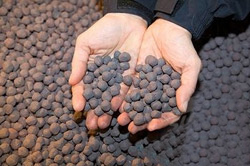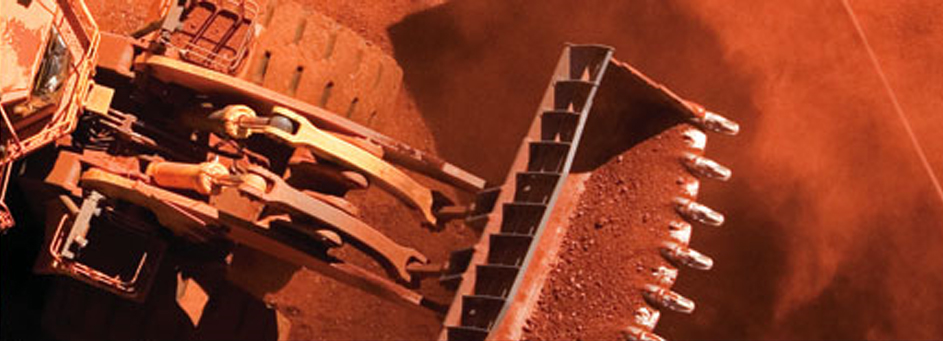 With gradual depletion of high Iron Ore reserves, the Iron and Steel sector world over has been looking at alternatives to utilise the low grade iron ore fines for iron making so that there is optimal utilisation of the available iron ore resources. Growth of Steel Industry, especially in China over the years despite the depletion of high grade Iron Ore has taken place on the strength of technologies of Beneficiation, Sintering and Pelletisation of Iron Ore Fines, which enhances the productivity of the blast furnaces in Steel making and hence lowering the cost of steel production. With gradual depletion of high Iron Ore reserves, the Iron and Steel sector world over has been looking at alternatives to utilise the low grade iron ore fines for iron making so that there is optimal utilisation of the available iron ore resources. Growth of Steel Industry, especially in China over the years despite the depletion of high grade Iron Ore has taken place on the strength of technologies of Beneficiation, Sintering and Pelletisation of Iron Ore Fines, which enhances the productivity of the blast furnaces in Steel making and hence lowering the cost of steel production.
In the Indian context, by the year 2020, India’s production of steel is expected to touch 110 Million Tonnes from the current level of approximately 45-50 Million Tonnes. It is imperative that the fines generated in the mining of iron ore be utilized for the production of steel. The Indian steel industry which predominantly uses expensive lump ore is gradually moving towards usage of sintered ore and pellets. It is in this context that Xindia Steels Limited has commissioned its Pellet plant, to produce Iron Ore pellets of consistent quality, which results in substantially higher efficiencies, both in production of DRI(Sponge Iron) and also in blast furnaces for production of iron.
Xinxing’s pelletizing technology (upto 3.0 MTPA) is considered among the best in the world, as it results in superior quality of pellets at lower costs of production. The pellets produced by Xindia will cater, both to the domestic iron and steel industry and also to burgeoning export markets in China, Japan, Korea, which are largely dependant on imported Iron Ore to feed their blast furnaces and DRI(Sponge Iron) kilns.
Pelletisation is a major process of agglomeration where micro fines, either in the form of beneficiated concentrate or without beneficiation are rolled into green balls (9-16 mm) before subjecting them to high temperature for heat hardening . The other major route of agglomeration is sintering .
The fundamental difference between sintering and pelletisation is that while the coarser spectrum of fines of the order of 'mm' are gainfully utilized in sintering process, the microfines or the so called ultra fines of the order of 'micron' which otherwise is unsuitable for production of sinter, are utilized in pelletisation.
There are two major processes dominating the world pelletisation scenario. While Travelling Grate (TG) process, developed by Outokumpu formerly Lurgi, Germany accounts for about 56% of the world capacity, GrateKiln (GK) process, developed by Metso Minerals (Formerly Boliden-Allis / Allis Chalmers, USA), accounts for about 33 % . Both TG and GK process have flexibility of operation using various type of iron are like Magnetite , Haematite magnetite/ Haematite etc. with capacity varying from small scale to very large scale.
Grate Kiln (GK) Process
The unit comprises three equipment viz grate, rotary kiln and circular cooler.
The green balls are first dried and preheated on the straight grate by gases discharged from the rotary klin followed by hardening in a counter flow manner in the rotary kiln and air cooling in an annular circular cooler.
The grate has two or more wind boxes to provide for the gas draught . The heat for drying and preheating is supplied by the gases discharged from the rotary kiln, and
hot air from the cooler is utilised in the rotary kiln.
What is Pelletization?
The process of Pelletization helps converting Iron Ore Fines into “Uniform Size Iron Ore Pellets” that can be fed in the blast furnaces or in the DRI kiln (DRI).
Why Pelletization?
Pelletization is the only answer to a major question of preserving our precious iron ore and using it wisely.
Advantages of Pellets
Pellets are uniformely sized, with purity of 63%- 68% contributing to faster reduction and high metallization rates.
Pellets with their high, uniform mechanical strength and high abrasive strength increase production of sponge iron by 25% to 30% with same amount of fuel.
Standardization - Uniform size range, generally within a range of 9-16 mm.
Purity - 63% to 68 % iron, mainly (Fe2O3).
Cost-effectiveness - There is no loss of handling iron ore, as pellets will not break during transport or handling. Reduces coal consumption in spong iron making with lower fines generation. Maintenance cost is low as there is not need for crushing and screening of iron ore lumps.
Strength - High and uniform mechanical strength even under thermal stress.
Productivity
A wholesome 20-25% increse in sponge iron making. A perceptible improvement in productivity of iron making through blast furnace route due to the uniformity of pellets which results in better permeability
.
Process
The Grate – Kiln technology
Proven and time tested technology of pelletisation with adoption of completely automated processes and equipment to ensure end product quality.
Capacity to produce 0.8 million tonnes of pellets per annum
For the complete pelletisation process please click here
PELLET SPECIFICATION
|


 With gradual depletion of high Iron Ore reserves, the Iron and Steel sector world over has been looking at alternatives to utilise the low grade iron ore fines for iron making so that there is optimal utilisation of the available iron ore resources. Growth of Steel Industry, especially in China over the years despite the depletion of high grade Iron Ore has taken place on the strength of technologies of Beneficiation, Sintering and Pelletisation of Iron Ore Fines, which enhances the productivity of the blast furnaces in Steel making and hence lowering the cost of steel production.
With gradual depletion of high Iron Ore reserves, the Iron and Steel sector world over has been looking at alternatives to utilise the low grade iron ore fines for iron making so that there is optimal utilisation of the available iron ore resources. Growth of Steel Industry, especially in China over the years despite the depletion of high grade Iron Ore has taken place on the strength of technologies of Beneficiation, Sintering and Pelletisation of Iron Ore Fines, which enhances the productivity of the blast furnaces in Steel making and hence lowering the cost of steel production.